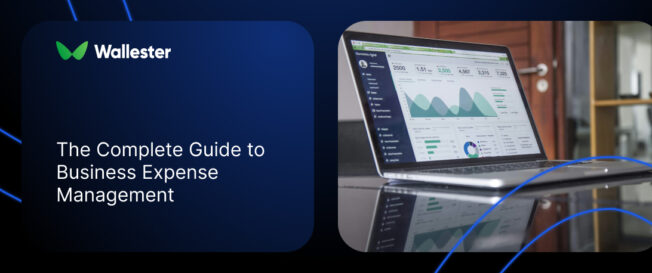Business travel expenses are often difficult to manage. Employees keep requesting reimbursements, finance teams struggle to process receipts, and the travel budget regularly goes over plan. However, this doesn’t have to be a constant problem. Many companies are finding better ways to handle travel costs by using modern tools. Virtual cards, in particular, offer a more efficient approach that gives companies greater control while making the process easier for both employees and finance departments.
Key takeaways
- Travel expense management tools simplify bookings, payments, approvals, and reimbursements.
- A clear policy helps avoid confusion and keeps spending under control.
- Virtual cards offer a secure, flexible way to handle travel payments without relying on reimbursements.
- Platforms like Wallester, Divvy, and Yokoy give companies better visibility and help finance teams stay in control.
How does travel and expense management work?
Let’s start with the basics. Traditional travel and expense management is pretty straightforward, but it’s also incredibly inefficient. An employee goes on a business trip, pays for everything out of pocket, then comes back with a stack of receipts. They fill out expense forms and submit them to their manager, who then sends them to finance for approval and reimbursement.
This old-school approach creates problems everywhere. Finance teams spend hours matching receipts to card transactions, checking if everything complies with company policies and processing payments. Meanwhile, employees are waiting weeks to get their money back, which isn’t exactly great for morale.
Modern expense management software has started changing this game. Instead of paper receipts and manual data entry, everything happens digitally. Employees can snap photos of receipts, categorise expenses on the spot, and track their reimbursement status in real time. Finance teams get access to all this data through one dashboard, making it much easier to spot spending patterns and control costs.
The real game-changer comes when you integrate booking platforms with expense management systems. When someone books flights through your approved channels, that transaction data flows directly into your expense system. No more manual entry, fewer errors, and much better control over corporate travel spending.
Further Reading: The Complete Guide to Business Expense Management
Issues associated with inefficient T&E processes
Here’s where things get messy with traditional expense management. The reconciliation process alone can eat up days of your finance team’s time every month. They’re stuck matching receipts with transactions, double-checking calculations, and hunting down missing documentation. It’s tedious work that nobody enjoys, and it’s surprisingly error-prone.
But the real problem is visibility – or rather, the lack of it. Most companies have no idea what they’re spending on travel until it’s too late. By the time you realise someone’s blown through their budget on expensive hotels or last-minute flights, the damage is already done.
Then there’s the compliance nightmare. Different departments handle expenses differently, some employees are meticulous with documentation, others… not so much. This inconsistency makes it nearly impossible to generate accurate reports or demonstrate that expenses were genuinely incurred for business purposes. When audit time comes around, you’re scrambling to piece together a picture of your spending.
The worst part? Policy violations often go unnoticed until it’s too late. Without proper tracking and controls, employees might accidentally (or intentionally) breach company guidelines, potentially landing you in hot water with tax authorities or creating awkward conversations with management about budget overruns.
What you need to know about designing a travel and expense policy
Creating a travel policy that actually works requires some serious thought. You need to strike a balance between giving employees the flexibility they need and maintaining control over costs. Start by clearly defining what counts as a legitimate business expense and set realistic spending limits for different categories.
Think about your company’s specific needs. A tech startup might have different requirements than a manufacturing company with clients worldwide. Consider factors like employee seniority, trip duration, and destination when setting limits. Your sales director travelling to New York for a week-long conference will have different needs than someone making a day trip to a nearby city.
Your approval process should make sense for your organisation size and structure. Small expenses can often be auto-approved, but you’ll want manager sign-off for bigger amounts. The key is avoiding bureaucracy that slows everyone down while still maintaining appropriate oversight.
Don’t set your policy in stone and forget about it. Business needs change, costs fluctuate, and what worked last year might not work now. Schedule regular reviews with input from different departments to keep your guidelines current and practical.
How to manage business travel expenses
Effective travel expense management starts well before the journey. Ask your team to plan ahead, estimate costs based on the destination, and seek approval for anything that may exceed standard policy. This kind of preparation helps keep spending predictable and avoids budget issues later on.
While the trip is underway, make tracking as straightforward as possible. Mobile apps that capture receipts and connect with your expense management system reduce errors and save time. Real-time data gives finance teams a clear view of what’s being spent as it happens, making it easier to flag unusual activity.
Once the trip is complete, focus on processing claims without unnecessary delays. Reimbursements should happen quickly and accurately. Automation can help by:
- Matching receipts to transactions
- Highlighting out-of-policy spending
- Routing approvals to the correct managers
Virtual cards can simplify the process even further. Employees use company-issued cards with pre-set limits, so they don’t have to cover costs themselves. Every payment is tracked automatically, reducing paperwork and giving the finance team more control over company spending.
What types of travel expenses are tax-deductible?
In most cases, expenses must be entirely for business purposes to qualify. While the exact rules vary between countries, there are some common categories to consider.
In the UK, transportation costs are usually the largest share of deductible travel spending. This includes flights, trains, taxis, and mileage for personal vehicles used on business. Employers can reimburse up to 45p per mile for the first 10,000 miles without creating a taxable benefit. Beyond that, the rate drops to 25p per mile.
Accommodation costs are usually deductible when overnight stays are required for work. Standard hotel bookings, serviced flats, or similar arrangements are allowed. However, personal extras such as minibar purchases or room service beyond reasonable meals may be excluded.
Meal expenses are usually accepted if they are reasonable and connected to business travel. This covers breakfast, lunch, and dinner while away from the regular workplace. Expensive or entertainment-focused meals may not qualify.
Other common tax-deductible expenses include:
- Parking fees and road tolls
- Conference or seminar registration costs
- Office supplies or equipment bought during the trip
- Mobile phone charges and internet access used for business
Maintaining clear records and staying within policy guidelines is important when submitting these expenses for tax relief. A reliable expense management system can make this process much easier.

What are virtual cards and why do we need them for travel expense management?
What are virtual cards?
Think of virtual cards as regular credit cards that live in the digital world. They have all the same components – card numbers, expiry dates, security codes – but they exist only as data in computer systems. You can use them for online purchases, mobile payments, and increasingly for in-person transactions through digital wallets.
The real magic happens with the control features. Virtual cards can be created instantly for specific purposes, like a single business trip or payments to a particular supplier. You can set spending limits, restrict certain types of purchases, and even set expiry dates that align with your business needs.
Most virtual cards are issued through expense management platforms or specialised banking solutions that integrate with your existing financial systems. Users access their cards through mobile apps or web interfaces.
Modern virtual card solutions offer automatic receipt matching, policy enforcement, and detailed spending analytics. These features transform virtual cards from basic payment tools into comprehensive expense management solutions.
Benefits of virtual cards
Virtual cards offer several advantages when managing business travel expenses:
- Security. Each card is tied to a specific purpose. If stolen or misused, it can be blocked instantly.
- Control. Spending limits and expiry dates are set in advance. Cards can only be used with approved vendors or during a set timeframe.
- Real-time tracking. Finance teams can see when and where money is spent, without waiting for employees to return.
- Simplified reconciliation. Since every card is tied to a transaction or booking, it’s easier to match payments with receipts.
- No need for reimbursement: Employees don’t have to pay out of pocket, removing financial stress and delays.
For companies dealing with frequent travel, especially across multiple countries, virtual cards reduce both complexity and risk.
Further Reading: Why Virtual Cards are Essential for Modern Travel Agencies
How virtual cards can enhance travel expense management
Virtual cards become even more powerful when they’re linked to an expense management system. Here’s how they improve each step of the process:
- Before the trip. A virtual card is issued for a specific trip or booking, with clear limits and policy rules attached.
- During the trip. The employee uses the card for bookings, meals, taxis, or other work-related expenses. The transaction data appears instantly in the system.
- After the trip. Receipts are matched to transactions automatically. Approvals are routed through the system, and reporting happens in real time.
This setup gives the finance team more control without burdening employees. Instead of collecting paper receipts and chasing claims, the system does the legwork. And if a card is misused or a claim falls outside the policy, it can be flagged right away.
It also makes it easier to apply company rules consistently across departments and countries. You can set rules that automatically block certain categories, require extra approval for higher amounts, or flag duplicate spending.
Further Reading: The Ultimate Guide to Virtual Card Solutions for Travel Companies
How to manage travel and expenses the best way
Success in travel expense management comes down to getting the right combination of technology, policies, and processes working together. The foundation is choosing software that can handle the complexity of modern business travel while being simple enough for everyone to actually use.
Integration between systems is extremely important. Your expense platform needs to talk to your accounting software, booking tools, and payment systems. When everything works together, you get a complete picture of travel spending without data living in isolated silos.
Don’t underestimate the importance of training and communication. People need to understand not just how to use new systems, but why the changes benefit them personally. Keep monitoring and improving your processes. Set up key performance indicators for your expense management and track them over time. Regular reviews of spending patterns, policy compliance, and system performance help you identify what’s working and what needs adjustment.
Integrated travel management system
A travel management system helps companies centralise bookings. Instead of letting employees choose their own websites or vendors, bookings happen through a unified tool that offers:
- Access to pre-approved vendors and negotiated rates.
- Automated approval flows tied to company policies.
- Built-in risk assessment and travel alerts.
- Integration with expense tracking platforms.
This saves time on searching for deals and helps keep bookings aligned with the travel budget.
Platform for expense management
An expense management platform handles everything from receipts to reimbursements. It keeps the process clean, transparent, and scalable. For finance teams, it removes the guesswork from reporting and makes it easier to spot unusual patterns.
Look for platforms that offer:
- Real-time card transactions and categorisation.
- Mobile apps for uploading receipts.
- Automatic matching of receipts to expenses.
- Policy enforcement built into the system.
- Customisable reporting dashboards.
Together, these features help companies simplify travel spending without losing control.
Top 3 solutions for travel expense management
Wallester: for the UK
Wallester provides a comprehensive virtual card and expense management solution tailored to the needs of UK-based businesses. It allows companies to issue virtual and physical cards instantly, configure detailed spending controls, and integrate easily with widely used UK accounting systems such as Xero and QuickBooks. The platform is developed with UK compliance standards in mind, making it suitable for firms operating within the British regulatory and financial environment.
Its expense management tools support automatic transaction categorisation, receipt matching, and real-time tracking. These features give finance teams a clear view of all business travel expenses as they happen. Spending caps, merchant category restrictions, and time-limited card validity support internal policy enforcement and help companies stay within budget.
Virtual cards can be created for single-use purposes, such as individual trips or bookings, or assigned for longer-term use by departments or employees. They are accepted by major travel providers both in the UK and abroad, covering flights, accommodation, transport, and other work-related purchases.
The platform’s reporting dashboard provides a detailed view of company spending. It highlights travel expense trends and identifies potential areas for savings while supporting accurate financial records and compliance requirements.
Key features of Wallester’s travel expense solution:
- Instant virtual and physical card issuance
- Custom spending limits and category controls
- Real-time transaction tracking and notifications
- Receipt capture and automated matching
- Full integration with UK accounting platforms
- Detailed travel expense reporting and policy support
Wallester is particularly well-suited for small and medium-sized enterprises looking for a secure, flexible, and locally optimised way to manage travel expenses without relying on manual reimbursement processes.
Divvy: for the US
Divvy offers a combined platform for virtual cards, expense tracking, and budgeting, tailored to the needs of businesses operating in the United States. It integrates with US banking infrastructure and complies with American financial regulations. The system suits companies that require clear visibility and control over travel spending, especially when travel represents a significant part of operational costs.
Divvy’s virtual card system supports instant issuance, allowing companies to create individual cards for employees, departments, or specific trips. Each card can be configured with custom limits, time frames, and category restrictions, helping enforce policy rules while giving employees flexibility to manage bookings and daily expenses.
The cards work smoothly with major US travel booking services and are accepted by a wide range of airlines, hotels, and transport providers. Employees can manage their arrangements directly without relying on personal funds or manual reimbursements.
Key features include:
- Receipt capture through mobile apps
- Automatic categorisation of expenses
- Live budget tracking
- Accounting system integration
The budgeting tools allow administrators to assign travel budgets by team, project, or location. Virtual cards apply these limits automatically, keeping spending aligned with internal plans.
Yokoy: for DACH
Yokoy offers advanced expense management tools for companies across the DACH region, covering Germany, Austria, and Switzerland. The platform combines artificial intelligence with detailed expense tracking to support the needs of businesses with domestic and cross-border travel requirements. Its regional orientation helps companies meet regulatory standards and align processes with local expectations.
AI-driven features support receipt processing, expense categorisation, and automated checks for suspicious transactions. The system handles receipts in multiple languages and currencies, which is useful for companies managing international trips or operating across several European markets.
Yokoy’s virtual cards give companies control over spending in real time. Cards can be issued for individual trips or teams and configured with specific usage rules. These settings enforce internal policies and restrict unapproved transactions without limiting essential business purchases. The cards are connected to European banking systems, which helps maintain transaction speed and payment accuracy.
Compliance support is a core part of the platform. Yokoy includes features for VAT reclaim, detailed audit trails, and reporting functions suited to local tax and accounting requirements. These tools help companies maintain consistent financial records and meet documentation standards across all jurisdictions they operate in.
Further Reading: Top 5 Payment Challenges Faced by OTAs and How to Overcome Them
Revolutionise your travel expense management with Wallester’s virtual cards
Wallester offers a virtual card solution that gives UK companies greater control over travel expenses while simplifying workflows for finance teams and employees. The platform combines flexible card management with real-time tracking and native integration with UK accounting systems, making it well-suited for companies looking to modernise how they manage business travel.
Wallester’s virtual cards can be issued instantly for specific trips, departments, or employees. Each card comes with configurable controls – daily or total spending limits, merchant category restrictions, and expiry settings. Transactions appear in real time, allowing finance teams to monitor spending as it happens and address irregularities immediately.
Cards can be tied to individual travel events and automatically closed once the trip is complete, reducing the risk of unauthorised use. If a security issue arises, cards can be cancelled and reissued without delays or disruption.
Integration with tools like Xero and QuickBooks allows financial data to sync directly into the company’s accounting system. Built-in policy enforcement guarantees spending stays aligned with internal guidelines.
Wallester also provides detailed reporting tools that help identify trends, spot unnecessary costs, and adjust travel policies based on actual data.
Key benefits of Wallester’s travel expense solution:
- Instant virtual card issuance with custom limits and expiry settings
- Real-time transaction tracking for full visibility
- Built-in controls for category restrictions and policy alignment
- Fast cancellation and reissue in case of security concerns
- Direct integration with major UK accounting platforms
- Reporting tools to analyse travel spend and adjust policies accordingly
Try Wallester’s platform if you are seeking a more structured, secure, and transparent way to manage travel spending.


